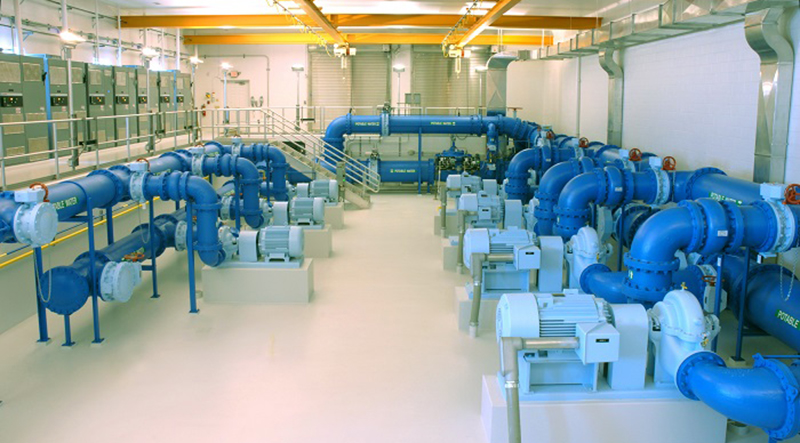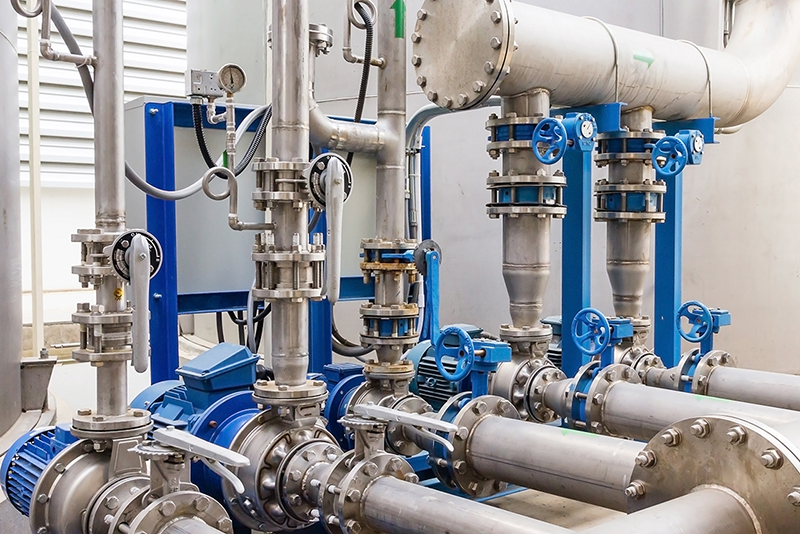Energy-efficient pumps differ from outmoded pumps and utilize less energy, resulting in maximum output. These pumps are designed to execute different applications, including water supply systems, wastewater management systems, and cooling and heating procedures.
There are several ways to increase the energy efficiency of an industrial centrifugal pump. One of the most efficient methods is to utilize the speed drive allowing the industrial pump to regulate its pace while balancing the flow. It helps save ample energy while decreasing the flow of water that has been propelled when a lesser flow is required.
Enhancing the design of the pump is another way to increase the efficiency of centrifugal industrial pumps by reducing the frictional losses in the pump’s components or using more efficient impeller designs. This can also reduce energy consumption by allowing the pump to operate more efficiently.
Finally, regular maintenance and monitoring can help ensure the pump operates efficiently. This can include cleaning the pump, checking for leaks or blockages, and monitoring the pump’s performance over time.
What Are The Steps Involved In Choosing Energy-Efficient Pumps?
Selecting energy-efficient pumps is essential for reducing energy consumption and operational costs in various industries. Here are fewer steps to consider when choosing energy-efficient pumps:
Assessing The Efficiency Of The Pump
Picking an energy-efficient pump requires assessing its efficiency through various methods to make an informed decision. Hydraulic efficiency measures a pump’s ability to convert power into hydraulic power and is expressed as the ratio of hydraulic power output to power input. High hydraulic efficiency indicates less energy waste and lower energy consumption.
Mechanical efficiency measures energy lost due to friction and other mechanical losses. It is expressed as the ratio of hydraulic power output to power input minus power loss due to mechanical failures. Specific speed is a dimensionless number representing a pump’s most efficient operating speed, which is vital in selecting the right pump for a particular application.
The pump curve represents a pump’s performance, showing the relationship between flow rate and head generated, allowing determination of efficiency and operating point. Operating at the best efficiency point on the pump curve can maximize efficiency and reduce energy consumption.
The System Curve
The system curve is a visual representation of the pressure and flow rate needed by a system. Considering the system curve while picking an industrial energy-efficient pump is essential to ensure it operates efficiently and doesn’t waste energy. Several key points should be kept in mind to assess the system curve.
The system head is the pressure required to overcome resistance and deliver the desired flow rate.
The pump head is the pressure the pump generates at a specific flow rate. The pump head and system head determine the pump’s operating point on the pump curve. Choosing an efficient pump can maximize productivity and diminish energy consumption.
It’s also essential to determine the system flow rate accurately and select a pump that meets system requirements without throttling, which can lead to energy losses and reduced efficiency. The operating point, where the pump curve intersects the system curve, represents the flow rate and pressure required by the system and the pump’s ability to deliver the necessary flow and pressure efficiently.

Selection Of A Pump
Choosing the right size of centrifugal energy efficient pump plays a vital role in the productive operation and minimizing energy utilization. Therefore, the pump size should be selected based on the system requirements, such as flow rate, pressure, and fluid properties, to ensure that the pump can meet these requirements efficiently without being oversized or under-sized.
Additionally, the net positive suction head required (NPSHR) should be considered, as selecting a pump with a lower NPSHR can reduce the pump size and minimize energy consumption. The pumping distance or the vertical lift the system requires can also affect the pump size.
System components such as pipes, fittings, and valves can impact the pump size. Selecting a pump that operates at or close to its best efficiency point (BEP) can maximize efficiency and reduce energy consumption. Overall, carefully considering these factors can ensure the correct size pump is chosen for efficient operation and minimal energy consumption.
Choosing The Right Impeller
The impeller plays a vital role in generating flow and pressure in a pump. However, choosing the right impeller type is challenging, as it can significantly affect pump performance, energy consumption, and operating costs. Therefore, various factors must be considered when selecting the appropriate impeller type.
Firstly, fluid properties such as viscosity, density, and corrosiveness should be considered. Different impeller types are designed to handle various fluid properties. For example, a radial impeller is suitable for low-viscosity fluids, while a mixed-flow impeller is suitable for high-viscosity liquids.
Additionally, the impeller type should be selected based on the required flow rate and head. Different impeller types have unique performance characteristics that can impact the flow rate and charge. Therefore, choosing an impeller that operates at or near its best efficiency point (BEP) is crucial to maximize efficiency and minimize energy consumption.
The impeller type can also affect the pump’s net positive suction head required (NPSHr), impacting the pump size and energy consumption.

Consider Motor Efficiency
Selecting an energy-efficient industrial pump requires considering the efficiency of its motor. The motor drives the impeller, which generates the flow and pressure necessary for the application. Therefore, motor efficiency can significantly impact energy consumption and operating costs.
Most countries have established motor efficiency standards. The higher the motor efficiency, the lower the energy consumption and operating costs. Premium efficiency motors meet or exceed the minimum efficiency standards set by regulatory agencies.
Although they may cost more, the energy savings over the motor’s lifetime can offset this. Motor size can also affect efficiency. An oversized motor can result in inefficient operation, while an undersized motor can lead to poor pump performance. Regular maintenance, such as cleaning and lubricating bearings, can help maintain efficiency and extend the motor’s lifespan. Operating conditions, such as high or low ambient temperatures, can also affect efficiency, so operating the motor within its specified temperature range is essential.
Select Pumps With Integrated Controls
Centrifugal industrial pumps with integrated controls can improve energy efficiency and performance by adjusting the pump speed and flow rate in response to changes in system demand. Various pump control systems are available, some with built-in controls that detect and respond to changes in order, while others require external control systems like VFDs.
Pumps equipped with sensors can also detect changes in system demand and adjust the pump speed and flow rate accordingly, resulting in more efficient operation and reduced energy consumption. In addition, built-in diagnostic systems can detect potential issues before they become critical, reducing maintenance costs and downtime.
Pumps with integrated controls can communicate with external systems like BMS or SCADA to provide real-time data on pump performance and energy consumption. This enables operators to optimize pump performance and reduce energy usage.

Look For Pumps With Energy Star Certification
Energy Star certification is a program that identifies energy-efficient pumps. Pumps that meet the strict energy efficiency criteria of the program operate more efficiently, consume less energy, and produce fewer greenhouse gas emissions than non-certified pumps.
Energy Star certification criteria are based on industry standards and best practices for energy efficiency, and pumps must meet or exceed these criteria to receive certification. Although the requirements may vary depending on the type and size of the pump, Energy Star-certified pumps are generally designed to operate more efficiently and consume less energy than comparable non-certified pumps.
Choosing Energy Star-certified pumps can result in significant energy savings and lower environmental impact. Operators can save energy and reduce operating costs over the pump’s lifetime by choosing energy Star-certified pumps designed to operate more efficiently.
Conclusion
Industrial energy-efficient pumps are essential to reducing energy consumption and promoting sustainability in various industries. With the increasing focus on environmental awareness, energy-efficient centrifugal pumps effectively reduce energy costs and greenhouse gas emissions while maintaining productivity.
Individuals and businesses can significantly contribute to a sustainable future by investing in these pumps. The benefits of energy-efficient pumps are evident, including improved performance, reduced energy costs, longer lifespan, and decreased environmental impact.


